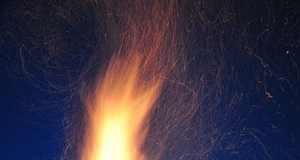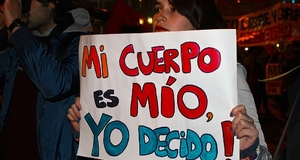Student VoicesHuman Rights in Chile: Remembrance and Reckoning
By
2009, Vol. 1 No. 11 | pg. 1/4 | »
IN THIS ARTICLE
KEYWORDS
It is important to note that information about human rights abuses in Chile, as well as the exact details and full connections of its recent political history, are still in the process of being sifted through, made public, gathered, and organized. According to the Guardian, “A large quantity of CIA and Pentagon documents about the 1973 coup in Chile and its aftermath were released...but human rights activists say vital information is still being withheld.” This has been especially true because of the nature of dictatorships, where opposition is repeatedly silenced and repressed; international organization of secrecy and covert action; security policies of cold war politics; and the societal traumatization that has undoubtedly influenced many to remain silent and/or anonymous. Most recently, when there was public pressure to prosecute Pinochet in Chile in 2001, the military itself made a “contribution to national reconciliation” and issued a list of 180 victims of the coup, whose bodies had been dumped into the sea. (http://www.remember-chile.org.uk, “Pinochet...”) As is examined indirectly in this article, official and common understandings of the history of human rights in Chile has been developing and solidifying as policy and governmental changes, both national and international, have allowed the facts to be known. This was particularly notable with the establishment of a transitional democracy, a democratically-elected president, and a National Truth and Reconciliation Commission in 1990. In discussing the formation of the South African Truth Commission, Antijie Krog, in her book Country of My Skull, describes her skepticism and relates the country’s situation to the results of the Chilean commission:
Politically speaking, however, the commision may have been the vehicle to really start the process of national reckoning that allowed for research into human rights abuses. In reference to the developments of the first half of the 1990s, reporter Hugh O’Shaughnessy states:
Other major events concerning human rights in Chile include the arrest of former dictator Augusto Pinochet in London in 1998, and the following extradition trial to try him for human rights abuses in Spain. This eventually led to changes in Chile with regard to the former dictator’s political power. In 2000, Chilean courts dissolved Pinochet’s parliamentary immunity and his formerly life-long position in Congress. An enormous step in the fight for human rights, these measures indicated more and more freedom in the country. Considering this larger picture, it may well be useful to provide a brief personal window view of the recent situation in Chile, thereby contributing to the recent discussions of Chilean society, and also allowing for an anthropological context for some sociocultural concerns in this paper. Here I hope to introduce some themes concerning societial trauma as a result of human rights abuse and the importance of memory and reckoning in a situation such as Chile’s. Developments in contemporary Chilean politics and society regarding human rights is reflective of a changing world, one that is post-cold war and one that, through international law and agencies, is struggling to uphold the universality of human rights. Grecia-Macul and Macrosocial ProcessGrecia-Macul, the street names of the intersection where the buildings are located, is also one of the names that referred to Universidad de Chile humanities campus. As an undergraduate from the U.S., on a junior year study-abroad program, finding the campus, where I enrolled in a literature class and a politics class, was a somewhat challenging task. Grecia-Macul was nowhere near the congested, highly-polluted city center. Nor was it in the quieter, eastern neighborhoods littered with fashionable business areas and quiet, affluent suburbs. Braving traffic, I eventually figured out the easiest bus route. I had no idea how significant the location would become, however, as representative of my experience in Chile and of the country’s situation in 1994. Grecia-Macul’s highway, the human traffic, and location on the margin of the city made it a particular location for guerrilla tactics and, in my mind, is forever linked to confrontation between those on the margin of government structures and military-like state enforcement. My memories of the guerrilla tactics, referred to in the media as student protests are not very clear. I was a 20-yr. old Latin American Studies major, with a strong interest in theatre and literature, who had read and studied about the political situation in Chile. I wasn’t trained as an Anthropologist and did not anticipate that very vivid, real experiences would eventually become harder and harder to remember. And I was busy, caught up in classwork and perhaps most significantly, in an immersion program. As part of learning about the culture, there was the experiencing of a culture. In Santiago, this was social culture that had been strongly reorganized and directed toward a certain type of socioeconomic development, and to competition in an international marketplace. There was a new metro system and the microbuses, in middle-class neighborhoods, every morning at 8AM, were literally overflowing with suited people on their way to work. The microbuses, I had been told, were different before Pinochet, all painted different colors, some with designs, whereas now they were all painted a standard pale yellow. This is one of the ways Chileans expressed differences of pre- and post-dictatorship to me, in describing small details and changes, unemotional and somehow representative of much deeper social forces and realities. It was similar when my hostess mother matter-of-factly pointed to where there had been bullet holes in her small, modest apartment from the night-time violence during the days of the coup. The need for Chilean society to heal and deal with their recent past was a topic of discussion for more than one professor. I always wondered about the limits of such a process when a military dictator was still part of national politics, in charge of military forces, as Pinochet was in 1994. This was a reality that contributed to the type of student protests at Grecia-Macul. My conclusion, after witnessing more than three protests, was that when people feel they cannot act within a system of government, they will act outside of it. Chile may have been operating under a new transitional democracy, after over fifteen years of dictatorship, but the social reality said something different. The first protests in the first semester of 1994 were about financial plans for students, who wanted more government assistance. Although they were not directly connected to the dictatorship, the role of the state in education was certainly approached differently under the Allende and Pinochet governments, with the former providing more government funds for education. Eventually, the same methods of protest were used to mark days of disappearances from the public university, La Chile, that occurred in the days of the coup and its aftermath. One protest, I remember, was for two students and one professor who had disappeared on a specific day, their bodies never recovered or whereabouts never known. Each protest at Grecia-Macul started the same way. (Sometimes there were parallel protests organized in the city center, at another campus, on the same day.) There was a group of buildings and lawn, wooded areas— not very big, about four city blocks— surrounded mostly by a high fence that separated the campus from major highways. From somewhere on campus, students or individuals (maybe 20) with black t-shirts wrapped around their faces appeared with Molotov cocktails and started climbing the fence. They would throw things into the highway, breaking up traffic and place themselves as human barriers, often burning a tire or regularly throwing Molotov cocktails. Usually some protestors stayed on the fence watching the scene below. Many by-standers fled to the other side of the campus when this happened, going onto side streets and reaching safe areas. Sometimes it was possible to catch a bus on a different highway, but the whole area was backed up with traffic shortly after the protests started. Other students on the campus would watch the spectacle from a distance or from the many windows in the building closest to the Grecia-Macul intersection, seeking shelter. One of the reasons for this kind of protest, I was told later, was a logical, tactical maneuver. In some of the reforms passed during the transitional democracy, the military police were forbidden to enter university campuses because of the many unwarranted disappearances, arrests, and cases of harassments during the dictatorship. The protestors could successfully break up traffic and create disturbance, with the eventual retreat option of climbing back over the fence and fleeing to safety on campus. This greatly affected everyone else, however, in the military counter-maneuver. The military police would move in slowly from either side of the highway, having to clear and get through traffic in order to do so. Protestors would continue to throw Molotov cocktails and block the streets with random objects. The police used tanks and carried fireproof shields, managing to approach in safety by tear-gassing the area in front of them. This usually affected the whole area— several city blocks or more. As they got closer to the scene of protest, the police would try to move in and arrest protestors, sometimes using rubber bullets, who usually managed to scramble back onto campus in safety. The military then proceeded to spray the campus with tear-gas until time had passed and all signs of protest had ended. The whole ordeal usually lasted several hours. As I joined other Chilean students— head on my desk, waiting for the air to become bearable; watching the action of the protest from a building; or running across campus trying to find an exit— I was invariably initiated into part of the modern Chilean experience. Many of the students felt helpless about the situation. They were uncomfortable with the violence and danger, but no attempts were made to prevent protests, that I saw. Someone always knew what the protests were about. There was a kind of legacy in being a student, it seemed, because so many of those who were targeted during the coup were students or university-affiliated. Graffiti about disappearances or political arrests were scattered about the campus, reminding students of this legacy. Within Chile’s governmental institutions and legal system, pluralistic reforms were occurring in 1989, with the democratic election of a new government. With human rights becoming a widely-recognized problem, there was a tension between the effects of military repression, the forgetting and denial of the human rights situation and the effects of trying to re-establish democracy and instigate social justice. A mental health team working with human rights victims in Santiago at the Latin American Institute of Mental Health and Human Rights (ILAS) in 1990 concluded that, "The institutionalization of political violence in this police state not only imposed traumatic experiences on its victims but also produced trauma at a macrosocial level." (134) This “macrosocial” level of trauma is exhibited in the country’s moves toward remembering and forgetting:
The student protests at Grecia-Macul in 1994 reflected how this general process was developing in Chilean society. The need to remember past human rights abuses was a major motivating factor in the protests. Equally significant, the perceived need to act outside forms of government and authority indicate that threats present during the military dictatorship were still very real.Continued on Next Page » Suggested Reading from Inquiries Journal
Inquiries Journal provides undergraduate and graduate students around the world a platform for the wide dissemination of academic work over a range of core disciplines. Representing the work of students from hundreds of institutions around the globe, Inquiries Journal's large database of academic articles is completely free. Learn more | Blog | Submit Latest in Anthropology |














